-
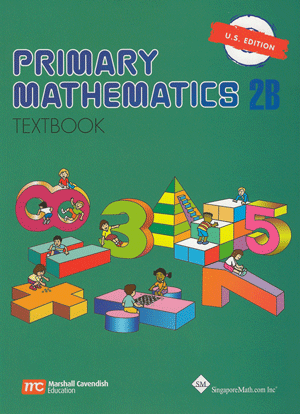
Go to
Placement Tests
Samples
Chapter 4: Fractions - Halves and Quarters
Chapter 5: Time - Telling Time
Chapter 6: Capacity - Comparing Capacity
Chapter 6: Capacity - Gallons, Pints and Cups
The Primary Mathematics U.S. Edition series of elementary math textbooks and workbooks is meant to be part of a system of learning in which adult supervision and independent practice go hand in hand. The main feature of this series is the use of the Concrete to Pictorial to Abstract approach. Students are provided with the necessary learning experiences beginning with the concrete and pictorial stages, followed by the abstract stage to enable them to learn mathematics meaningfully. This approach encourages active thinking process, communication of mathematical ideas and problem solving, which helps develop the foundation students will need for more advanced mathematics.
Practice exercises are designed to provide the students with further practice after they have done the relevant workbook exercises. Review exercises are provided for cumulative reviews of concepts and skills. All the practice exercises and review exercises are optional exercises.
The color patch

is used to invite active participation from the students and to facilitate oral discussion. The students are advised not to write on the color patches.
Above extract from Preface of Primary Mathematics U.S. Edition (reproduced with the permission of the publishers).
The textbooks contain the learning tasks for students to do under adult supervision and interaction, along with practice and review problems. They are meant to be non-consumable and to be used along with the Primary Mathematics Workbooks.
Answers or answer keys for Primary Mathematics U.S. Edition textbooks and workbooks are found in the teacher's guides and home instructor's guides. Answer keys booklets are also available - one for Primary 1-3 and one for Primary 4-6.
By:
$22.50
-

Go to
Placement Tests
Samples
Chapter 1: Numbers to 10,000 - Thousands, Hundreds, Tens and Ones
Chapter 3: Multiplication and Division - More Word Problems
Chapter 4: Multiplication Tables of 6, 7, 8 and 9 - Multiplying and Dividing by 6
Chapter 4: Multiplication Tables - Practice 4B
The Primary Mathematics U.S. Edition series of elementary math textbooks and workbooks is meant to be part of a system of learning in which adult supervision and independent practice go hand in hand. The main feature of this series is the use of the Concrete to Pictorial to Abstract approach. Students are provided with the necessary learning experiences beginning with the concrete and pictorial stages, followed by the abstract stage to enable them to learn mathematics meaningfully. This approach encourages active thinking process, communication of mathematical ideas and problem solving, which helps develop the foundation students will need for more advanced mathematics.
Practice exercises are designed to provide the students with further practice after they have done the relevant workbook exercises. Review exercises are provided for cumulative reviews of concepts and skills. All the practice exercises and review exercises are optional exercises.
The color patch

is used to invite active participation from the students and to facilitate oral discussion. The students are advised not to write on the color patches.
Above extract from Preface of Primary Mathematics U.S. Edition (reproduced with the permission of the publishers).
The textbooks contain the learning tasks for students to do under adult supervision and interaction, along with practice and review problems. They are meant to be non-consumable and to be used along with the Primary Mathematics Workbooks.
Answers or answer keys for Primary Mathematics U.S. Edition textbooks and workbooks are found in the teacher's guides and home instructor's guides. Answer keys booklets are also available - one for Primary 1-3 and one for Primary 4-6.
By:
$22.50
-

Go to
Placement Tests
Samples
Chapter 3: Weight - Kilograms and Grams
Chapter 3: Weight - Pounds and Ounces
Chapter 6: Fractions - Fraction of a Whole
Chapter 7: Time - Hours and Minutes
The Primary Mathematics U.S. Edition series of elementary math textbooks and workbooks is meant to be part of a system of learning in which adult supervision and independent practice go hand in hand. The main feature of this series is the use of the Concrete to Pictorial to Abstract approach. Students are provided with the necessary learning experiences beginning with the concrete and pictorial stages, followed by the abstract stage to enable them to learn mathematics meaningfully. This approach encourages active thinking process, communication of mathematical ideas and problem solving, which helps develop the foundation students will need for more advanced mathematics.
Practice exercises are designed to provide the students with further practice after they have done the relevant workbook exercises. Review exercises are provided for cumulative reviews of concepts and skills. All the practice exercises and review exercises are optional exercises.
The color patch

is used to invite active participation from the students and to facilitate oral discussion. The students are advised not to write on the color patches.
Above extract from Preface of Primary Mathematics U.S. Edition (reproduced with the permission of the publishers).
The textbooks contain the learning tasks for students to do under adult supervision and interaction, along with practice and review problems. They are meant to be non-consumable and to be used along with the Primary Mathematics Workbooks.
Answers or answer keys for Primary Mathematics U.S. Edition textbooks and workbooks are found in the teacher's guides and home instructor's guides. Answer keys booklets are also available - one for Primary 1-3 and one for Primary 4-6.
By:
$22.50
-
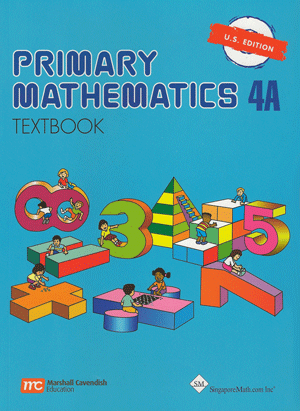
Go to
Placement Tests
Samples
Chapter 2: Multiplication and Division of Whole Numbers - Multiplication by a 1-digit Number
Chapter 3: Fractions - Improper Fractions
Chapter 3: Fractions - Practice 3C
Chapter 4: Tables and Graphs - Presenting Data
The Primary Mathematics U.S. Edition series of elementary math textbooks and workbooks is meant to be part of a system of learning in which adult supervision and independent practice go hand in hand. The main feature of this series is the use of the Concrete to Pictorial to Abstract approach. Students are provided with the necessary learning experiences beginning with the concrete and pictorial stages, followed by the abstract stage to enable them to learn mathematics meaningfully. This approach encourages active thinking process, communication of mathematical ideas and problem solving, which helps develop the foundation students will need for more advanced mathematics.
Practice exercises are designed to provide the students with further practice after they have done the relevant workbook exercises. Review exercises are provided for cumulative reviews of concepts and skills. All the practice exercises and review exercises are optional exercises.
The color patch

is used to invite active participation from the students and to facilitate oral discussion. The students are advised not to write on the color patches.
Above extract from Preface of Primary Mathematics U.S. Edition (reproduced with the permission of the publishers).
The textbooks contain the learning tasks for students to do under adult supervision and interaction, along with practice and review problems. They are meant to be non-consumable and to be used along with the Primary Mathematics Workbooks.
Answers or answer keys for Primary Mathematics U.S. Edition textbooks and workbooks are found in the teacher's guides and home instructor's guides. Answer keys booklets are also available - one for Primary 1-3 and one for Primary 4-6.
By:
$22.50
-
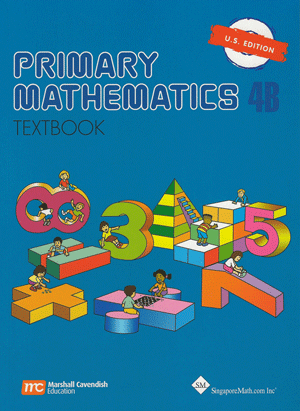
Go to
Placement Tests
Samples
Chapter 2: The Four Operations of Decimals - Addition and Subtraction
Chapter 4: Symmetry - Symmetric Figure
Chapter 6: Volume - Volume of a Cuboid
The Primary Mathematics U.S. Edition series of elementary math textbooks and workbooks is meant to be part of a system of learning in which adult supervision and independent practice go hand in hand. The main feature of this series is the use of the Concrete to Pictorial to Abstract approach. Students are provided with the necessary learning experiences beginning with the concrete and pictorial stages, followed by the abstract stage to enable them to learn mathematics meaningfully. This approach encourages active thinking process, communication of mathematical ideas and problem solving, which helps develop the foundation students will need for more advanced mathematics.
Practice exercises are designed to provide the students with further practice after they have done the relevant workbook exercises. Review exercises are provided for cumulative reviews of concepts and skills. All the practice exercises and review exercises are optional exercises.
The color patch

is used to invite active participation from the students and to facilitate oral discussion. The students are advised not to write on the color patches.
Above extract from Preface of Primary Mathematics U.S. Edition (reproduced with the permission of the publishers).
The textbooks contain the learning tasks for students to do under adult supervision and interaction, along with practice and review problems. They are meant to be non-consumable and to be used along with the Primary Mathematics Workbooks.
Answers or answer keys for Primary Mathematics U.S. Edition textbooks and workbooks are found in the teacher's guides and home instructor's guides. Answer keys booklets are also available - one for Primary 1-3 and one for Primary 4-6.
By:
$22.50
-
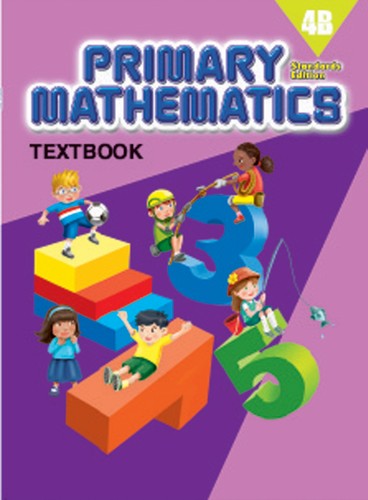
Textbooks present new concepts and learning tasks for students to complete with educator supervision. They include practice and review problems, and are designed to be used alongside workbooks.
Features & Components:
- Mathematical concepts are introduced in the opening pages and taught to mastery through specific learning tasks that allow for immediate assessment and consolidation.
- The Concrete Pictorial Abstract approach enables students to encounter math in a meaningful way.
- Direct correlation of the textbook to the workbook facilitates focused review and evaluation.
- The modeling method enables students to visualize and solve problems quickly and efficiently.
- New mathematical concepts are introduced through a spiral progression that builds on concepts already taught and mastered.
- Metacognition is employed as a strategy for learners to monitor their thinking processes in problem solving. Speech and thought bubbles provide guidance through the thought processes, making even the most challenging problems accessible to students.
- Color patches invite active student participation and facilitate lively discussion about concepts.
- Regular reviews in the textbook provide consolidation opportunities.
- The glossary effectively combines pictorial representation with simple mathematical definitions to provide a comprehensive reference guide for students.
Note: Two textbooks (A and B) for each grade correspond to the two halves of the school year. Answer key not included. Soft cover.
Take a Look Inside
Table of Contents
-
-
- DecimalsTenths
Hundredths
Thousandths
Practice A
Practice B
Rounding
Review 6
-
- The Four Operations of DecimalsAddition and Subtraction
Practice A
Practice B
Multiplication
Practice C
Division
Practice D
Practice E
Practice F
Review 7
-
- Congruent and Symmetric FiguresCongruent Figures
Tiling Patterns
Line Symmetry
Rotational Symmetry
Review 8
-
- Coordinate Graphs and Changes in QuantitiesThe Coordinate Grid
Changes in Quantities
Graphing Changes in Quantities
Review 9
-
- Data Analysis and ProbabilityOrganizing and Analyzing Data
Probability Experiments
Order of Outcomes
Bar Graphs
Line Graphs
Review 10
-
- Measures and VolumeAdding and Subtracting Measures
Multiplying Measures
Dividing Measures
Practice A
Cubic Units
Volume of Rectangular Prisms
Practice B
Practice C
Review 11
-
Grade Four Mathematics Content Standards
-
Glossary
Index
All copyrights reserved by Marshall Cavendish International (S) Pte Ltd.
By:
$33.95
-

Go to
Placement Tests
Samples
Chapter 1: Whole Numbers - Word Problems
Chapter 3: Fractions - Addition and Subtraction of Mixed Numbers
Chapter 5: Ratio - Equivalent Ratios
Review C (on customary measurements)
The Primary Mathematics U.S. Edition series of elementary math textbooks and workbooks is meant to be part of a system of learning in which adult supervision and independent practice go hand in hand. The main feature of this series is the use of the Concrete to Pictorial to Abstract approach. Students are provided with the necessary learning experiences beginning with the concrete and pictorial stages, followed by the abstract stage to enable them to learn mathematics meaningfully. This approach encourages active thinking process, communication of mathematical ideas and problem solving, which helps develop the foundation students will need for more advanced mathematics.
Practice exercises are designed to provide the students with further practice after they have done the relevant workbook exercises. Review exercises are provided for cumulative reviews of concepts and skills. All the practice exercises and review exercises are optional exercises.
The color patch

is used to invite active participation from the students and to facilitate oral discussion. The students are advised not to write on the color patches.
Above extract from Preface of Primary Mathematics U.S. Edition (reproduced with the permission of the publishers).
The textbooks contain the learning tasks for students to do under adult supervision and interaction, along with practice and review problems. They are meant to be non-consumable and to be used along with the Primary Mathematics Workbooks.
Answers or answer keys for Primary Mathematics U.S. Edition textbooks and workbooks are found in the teacher's guides and home instructor's guides. Answer keys booklets are also available - one for Primary 1-3 and one for Primary 4-6.
By:
$22.50
-
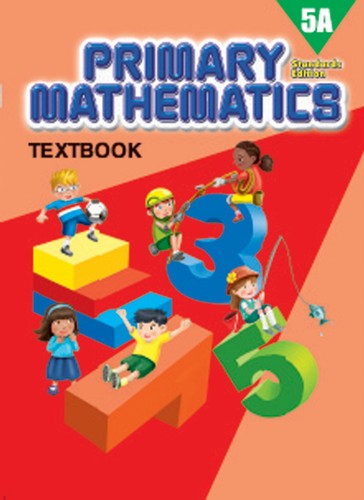
Textbooks present new concepts and learning tasks for students to complete with educator supervision. They include practice and review problems, and are designed to be used alongside workbooks.
Features & Components:
- Mathematical concepts are introduced in the opening pages and taught to mastery through specific learning tasks that allow for immediate assessment and consolidation.
- The Concrete Pictorial Abstract approach enables students to encounter math in a meaningful way.
- Direct correlation of the textbook to the workbook facilitates focused review and evaluation.
- The modeling method enables students to visualize and solve problems quickly and efficiently.
- New mathematical concepts are introduced through a spiral progression that builds on concepts already taught and mastered.
- Metacognition is employed as a strategy for learners to monitor their thinking processes in problem solving. Speech and thought bubbles provide guidance through the thought processes, making even the most challenging problems accessible to students.
- Color patches invite active student participation and facilitate lively discussion about concepts.
- Regular reviews in the textbook provide consolidation opportunities.
- The glossary effectively combines pictorial representation with simple mathematical definitions to provide a comprehensive reference guide for students.
Note: Two textbooks (A and B) for each grade correspond to the two halves of the school year. Answer key not included. Soft cover.
Take a Look Inside
Table of Contents
-
-
- Whole NumbersBillions
Approximation and Estimation
Practice A
Factors and Multiples
Prime Factorization
Practice B
Multiplying by Tens, Hundreds or Thousands
Dividing by Tens, Hundreds or Thousands
Practice C
Review 1
-
- More Calculations with Whole NumbersCalculations with Parentheses
Practice A
Methods for Mental Calculation
Practice B
Word Problems
Practice C
Multiplication by a 2-Digit Whole Number
Division by a 2-Digit Whole Number
Practice D
Review 2
-
- FractionsComparing Fractions
Fractions and Division
Practice A
Addition and Subtraction of Unlike Fractions
Practice B
Addition and Subtraction of Mixed Numbers
Practice C
Multiplying a Fraction and a Whole Number
Fraction of a Set
Practice D
Word Problems
Practice E
Review 3
-
- Multiply and Divide FractionsProduct of Fractions
Practice A
Word Problems
Practice B
Dividing a Fraction by a Whole Number
Practice C
Dividing by a Fraction
Practice D
More Word Problems
Practice E
Review 4
-
- Perimeter, Area and Surface AreaSquare Units
Rectangles and Squares
Practice A
Area of a Triangle
Practice B
Area of a Parallelogram
Surface Area
Review 5
-
- RatioFinding Ratio
Equivalent Ratios
Practice A
Combining Three Quantities
Practice B
Review 6
-
Grade Five Mathematics Content Standards
-
Glossary
Index
All copyrights reserved by Marshall Cavendish International (S) Pte Ltd.
By:
$33.95
-
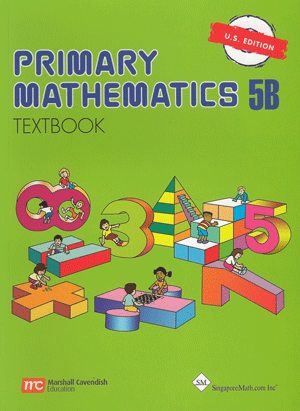
Go to
Placement Tests
Samples
Chapter 2: Percentage - Percentage of a Quantity
Chapter 3: Average - Average
Chapter 6: Triangles - Drawing Triangles
The Primary Mathematics U.S. Edition series of elementary math textbooks and workbooks is meant to be part of a system of learning in which adult supervision and independent practice go hand in hand. The main feature of this series is the use of the Concrete to Pictorial to Abstract approach. Students are provided with the necessary learning experiences beginning with the concrete and pictorial stages, followed by the abstract stage to enable them to learn mathematics meaningfully. This approach encourages active thinking process, communication of mathematical ideas and problem solving, which helps develop the foundation students will need for more advanced mathematics.
Practice exercises are designed to provide the students with further practice after they have done the relevant workbook exercises. Review exercises are provided for cumulative reviews of concepts and skills. All the practice exercises and review exercises are optional exercises.
The color patch

is used to invite active participation from the students and to facilitate oral discussion. The students are advised not to write on the color patches.
Above extract from Preface of Primary Mathematics U.S. Edition (reproduced with the permission of the publishers).
The textbooks contain the learning tasks for students to do under adult supervision and interaction, along with practice and review problems. They are meant to be non-consumable and to be used along with the Primary Mathematics Workbooks.
Answers or answer keys for Primary Mathematics U.S. Edition textbooks and workbooks are found in the teacher's guides and home instructor's guides. Answer keys booklets are also available - one for Primary 1-3 and one for Primary 4-6.
By:
$22.50
-
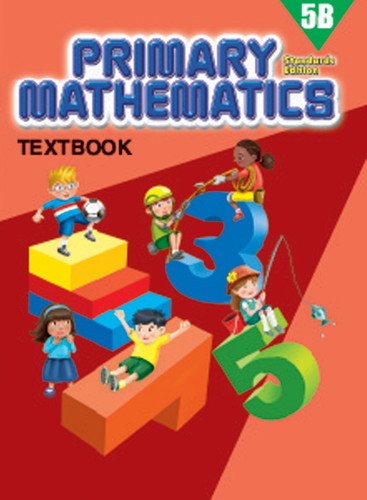
Textbooks present new concepts and learning tasks for students to complete with educator supervision. They include practice and review problems, and are designed to be used alongside workbooks.
Features & Components:
- Mathematical concepts are introduced in the opening pages and taught to mastery through specific learning tasks that allow for immediate assessment and consolidation.
- The Concrete Pictorial Abstract approach enables students to encounter math in a meaningful way.
- Direct correlation of the textbook to the workbook facilitates focused review and evaluation.
- The modeling method enables students to visualize and solve problems quickly and efficiently.
- New mathematical concepts are introduced through a spiral progression that builds on concepts already taught and mastered.
- Metacognition is employed as a strategy for learners to monitor their thinking processes in problem solving. Speech and thought bubbles provide guidance through the thought processes, making even the most challenging problems accessible to students.
- Color patches invite active student participation and facilitate lively discussion about concepts.
- Regular reviews in the textbook provide consolidation opportunities.
- The glossary effectively combines pictorial representation with simple mathematical definitions to provide a comprehensive reference guide for students.
Note: Two textbooks (A and B) for each grade correspond to the two halves of the school year. Answer key not included. Soft cover. |
Table of Contents
-
- Decimals
Tenths, Hundredths and Thousandths
Approximation
Add and Subtract Decimals
Multiply and Divide Decimals by a 1-Digit Whole Number
Practice A
Multiplication by Tens, Hundreds or Thousands
Division by Tens, Hundreds or Thousands
Multiplication by a 2-Digit Whole Number
Division by a 2-Digit Whole Number
Multiplication by a Decimal
Division by a Decimal
Practice B
Review 7
- Measures and Volume
Conversion of Measures
Practice A
Volume of Rectangular Prisms
Practice B
Review 8
- Percentage
Percent
Writing Fractions as Percentages
Practice A
Percentage of a Quantity
Practice B
Review 9
- Angles
Measuring Angles
Finding Unknown Angles
Sum of Angles of a Triangle
Isosceles and Equilateral Triangles
Drawing Triangles
Sum of Angles of a Quadrilateral
Parallelograms, Rhombuses and Trapezoids
Drawing Parallelograms and Rhombuses
Review 10
- Average and Rate
Average
Practice A
Rate
Practice B
Review 11
- Data Analysis
Mean, Median and Mode
Multiplying Measures
Histograms
Line Graphs
Pie Charts
Review 12
- Algebra
Algebraic Expressions
Practice A
Integers
Practice B
Coordinate Graphs
Review 13
-
-
Glossary
Index
Grade Five Mathematics Content Standards
By:
$33.95
-
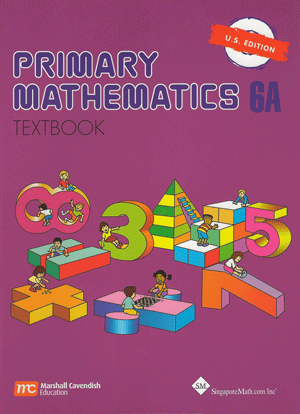
Go to
Placement Tests
Samples
Chapter 1: Algebra - Algebraic Expressions
Chapter 3: Ratio - Ratio and Fraction
Chapter 5: Speed - Average Speed
Review F (on customary measurements)
The Primary Mathematics U.S. Edition series of elementary math textbooks and workbooks is meant to be part of a system of learning in which adult supervision and independent practice go hand in hand. The main feature of this series is the use of the Concrete to Pictorial to Abstract approach. Students are provided with the necessary learning experiences beginning with the concrete and pictorial stages, followed by the abstract stage to enable them to learn mathematics meaningfully. This approach encourages active thinking process, communication of mathematical ideas and problem solving, which helps develop the foundation students will need for more advanced mathematics.
Practice exercises are designed to provide the students with further practice after they have done the relevant workbook exercises. Review exercises are provided for cumulative reviews of concepts and skills. All the practice exercises and review exercises are optional exercises.
The color patch

is used to invite active participation from the students and to facilitate oral discussion. The students are advised not to write on the color patches.
Above extract from Preface of Primary Mathematics U.S. Edition (reproduced with the permission of the publishers).
The textbooks contain the learning tasks for students to do under adult supervision and interaction, along with practice and review problems. They are meant to be non-consumable and to be used along with the Primary Mathematics Workbooks.
Answers or answer keys for Primary Mathematics U.S. Edition textbooks and workbooks are found in the teacher's guides and home instructor's guides. Answer keys booklets are also available - one for Primary 1-3 and one for Primary 4-6.
By:
$22.50
-

Textbooks present new concepts and learning tasks for students to complete with educator supervision. They include practice and review problems, and are designed to be used alongside workbooks.
Features & Components:
- Mathematical concepts are introduced in the opening pages and taught to mastery through specific learning tasks that allow for immediate assessment and consolidation.
- The Concrete Pictorial Abstract approach enables students to encounter math in a meaningful way.
- Direct correlation of the textbook to the workbook facilitates focused review and evaluation.
- The modeling method enables students to visualize and solve problems quickly and efficiently.
- New mathematical concepts are introduced through a spiral progression that builds on concepts already taught and mastered.
- Metacognition is employed as a strategy for learners to monitor their thinking processes in problem solving. Speech and thought bubbles provide guidance through the thought processes, making even the most challenging problems accessible to students.
- Color patches invite active student participation and facilitate lively discussion about concepts.
- Regular reviews in the textbook provide consolidation opportunities.
- The glossary effectively combines pictorial representation with simple mathematical definitions to provide a comprehensive reference guide for students.
Note: Two textbooks (A and B) for each grade correspond to the two halves of the school year. Answer key not included. Soft cover.
Take a Look Inside
Table of Contents
-
-
- AlgebraAlgebraic Expressions I
Practice A
Algebraic Equations
Practice B
Algebraic Expressions II
Practice C
Graphs of Functions
Practice D
Review 1
-
- Fractions and DecimalsFractions and Decimals
Negative Fractions and Decimals
Comparing Numbers
Practice A
- The Four OperationsAddition and Subtraction of Fractions
Practice A
Multiplication and Division of Fractions
Practice B
Review 2
-
- PercentagePercentage of a Quantity
Percentage of Change
Practice A
Simple Interest, Sales Tax and Discount I
Practice B
Simple Interest, Sales Tax and Discount II
Practice C
- Ratio and ProportionComparing Quantities I
Practice A
Comparing Quantities II
Practice B
Comparing Three Quantities
Practice C
Word Problems
Practice D
Proportion
Practice E
Review 3
-
- Rate and SpeedRate I
Practice A
Rate II
Practice B
Speed
Practice C
Average Speed
Practice D
Review 4
-
Glossary
Index
All copyrights reserved by Marshall Cavendish International (S) Pte Ltd.
By:
$33.95
-
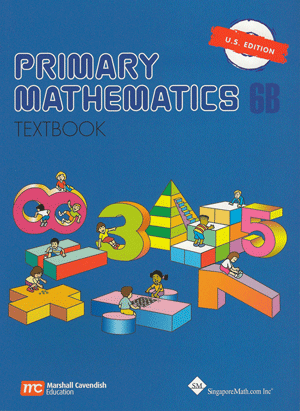
Go to
Placement Tests
Samples
Chapter 1: Fractions - Division
Chapter 1: Fractions - Word Problems
Chapter 2: Circles - Circumference
Chapter 4: Triangles and 4-sided Figures - Finding Unknown Angles
The Primary Mathematics U.S. Edition series of elementary math textbooks and workbooks is meant to be part of a system of learning in which adult supervision and independent practice go hand in hand. The main feature of this series is the use of the Concrete to Pictorial to Abstract approach. Students are provided with the necessary learning experiences beginning with the concrete and pictorial stages, followed by the abstract stage to enable them to learn mathematics meaningfully. This approach encourages active thinking process, communication of mathematical ideas and problem solving, which helps develop the foundation students will need for more advanced mathematics.
Practice exercises are designed to provide the students with further practice after they have done the relevant workbook exercises. Review exercises are provided for cumulative reviews of concepts and skills. All the practice exercises and review exercises are optional exercises.
The color patch

is used to invite active participation from the students and to facilitate oral discussion. The students are advised not to write on the color patches.
Above extract from Preface of Primary Mathematics U.S. Edition (reproduced with the permission of the publishers).
The textbooks contain the learning tasks for students to do under adult supervision and interaction, along with practice and review problems. They are meant to be non-consumable and to be used along with the Primary Mathematics Workbooks.
Answers or answer keys for Primary Mathematics U.S. Edition textbooks and workbooks are found in the teacher's guides and home instructor's guides. Answer keys booklets are also available - one for Primary 1-3 and one for Primary 4-6.
By:
$22.50
-
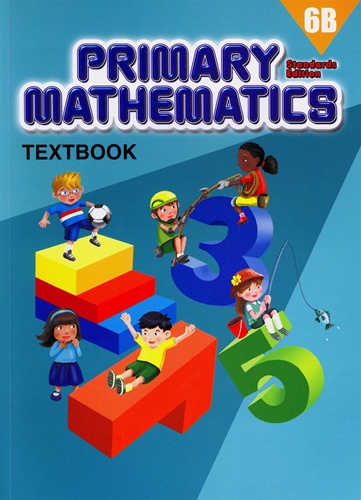
Textbooks present new concepts and learning tasks for students to complete with educator supervision. They include practice and review problems, and are designed to be used alongside workbooks.
Features & Components:
- Mathematical concepts are introduced in the opening pages and taught to mastery through specific learning tasks that allow for immediate assessment and consolidation.
- The Concrete Pictorial Abstract approach enables students to encounter math in a meaningful way.
- Direct correlation of the textbook to the workbook facilitates focused review and evaluation.
- The modeling method enables students to visualize and solve problems quickly and efficiently.
- New mathematical concepts are introduced through a spiral progression that builds on concepts already taught and mastered.
- Metacognition is employed as a strategy for learners to monitor their thinking processes in problem solving. Speech and thought bubbles provide guidance through the thought processes, making even the most challenging problems accessible to students.
- Color patches invite active student participation and facilitate lively discussion about concepts.
- Regular reviews in the textbook provide consolidation opportunities.
- The glossary effectively combines pictorial representation with simple mathematical definitions to provide a comprehensive reference guide for students.
Note: Two textbooks (A and B) for each grade correspond to the two halves of the school year. Answer key not included. Soft cover.
Take a Look InsideTable of Contents
-
-
- CircleCircumference
Area
Practice A
Composite Figures
Practice B
- Volume of Prisms and CylindersVolume of Prisms
Volume of Cylinders
Practice A
Review 5
-
-
- AnglesAdjacent Angles
Vertically Opposite Angles and Angles at a Point
Complementary Angles
Supplementary Angles
Practice A
Angles and Polygons I
Angles and Polygons II
Practice B
- Construction of Triangles and QuadrilateralsDrawing Lines and Angles
Constructing Triangles and Quadrilaterals
Practice A
Review 6
-
-
- Data HandlingMean
Population and Sample
Practice A
Median
Mode
Range
Practice B
- ProbabilityExperimental Probability
Practice A
Theoretical Probability of Simple Events I
Theoretical Probability of Simple Events II
Practice B
Theoretical Probability of Combined Events I
Theoretical Probability of Combined Events II
Practice C
Review 7
-
- Negative NumbersAddition and Subtraction
Multiplication and Division
Practice A
Order of Operations
Practice B
Solving Equations
Graph of Functions
Practice C
Review 8
-
Glossary
Index
All copyrights reserved by Marshall Cavendish International (S) Pte Ltd.
By:
$35.95
-
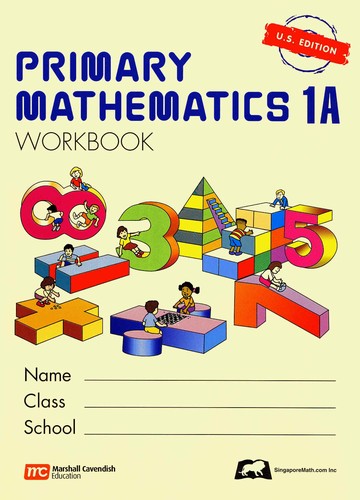
Go to
Placement Tests
Sample Pages:
Chapter 3: Addition - Exercise 17
Chapter 4: Subtraction - Exercise 28
Review 7
The
Primary Mathematics U.S. Edition series of elementary math textbooks and workbooks is meant to be part of a system of learning in which adult supervision and independent practice go hand in hand. The main feature of this series is the use of the Concrete > Pictorial > Abstract approach.
Students are provided with the necessary learning experiences beginning with the concrete and pictorial stages, followed by the abstract stage to enable them to learn mathematics meaningfully. This approach encourages active thinking process, communication of mathematical ideas and problem solving. This helps develop the foundation students will need for more advanced mathematics.
The above extract is from Preface of Primary Mathematics U.S. Edition (reproduced with the permission of the publishers).
The workbooks are consumable and should be used in conjunction with the textbooks. They contain the exercises the student does independently.
Answers or answer keys for Primary Mathematics U.S. Edition textbooks and workbooks are found in the teacher's guides and home instructor's guides. Answer keys booklets are also available for purchase - one for Primary 1-3 and one for Primary 4-6.
By:
$22.50
-
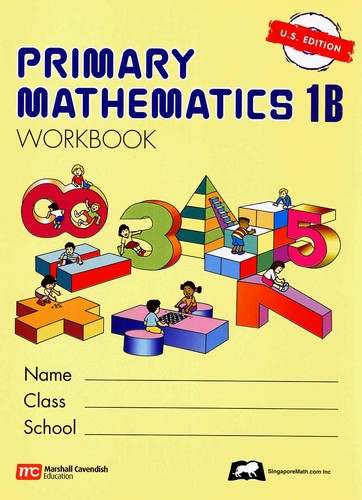
Go to
Placement Tests
Samples
Chapter 5: Division - Exercise 37
Chapter 8: Numbers to 100 - Exercise 52
Review 7
The
Primary Mathematics U.S. Edition series of elementary math textbooks and workbooks is meant to be part of a system of learning in which adult supervision and independent practice go hand in hand. The main feature of this series is the use of the Concrete > Pictorial > Abstract approach.
Students are provided with the necessary learning experiences beginning with the concrete and pictorial stages, followed by the abstract stage to enable them to learn mathematics meaningfully. This approach encourages active thinking process, communication of mathematical ideas and problem solving. This helps develop the foundation students will need for more advanced mathematics.
The above extract is from Preface of Primary Mathematics U.S. Edition (reproduced with the permission of the publishers).
The workbooks are consumable and should be used in conjunction with the textbooks. They contain the exercises the student does independently.
Answers or answer keys for Primary Mathematics U.S. Edition textbooks and workbooks are found in the teacher's guides and home instructor's guides. Answer keys booklets are also available for purchase - one for Primary 1-3 and one for Primary 4-6.
By:
$22.50
 is used to invite active participation from the students and to facilitate oral discussion. The students are advised not to write on the color patches.
Above extract from Preface of Primary Mathematics U.S. Edition (reproduced with the permission of the publishers).
The textbooks contain the learning tasks for students to do under adult supervision and interaction, along with practice and review problems. They are meant to be non-consumable and to be used along with the Primary Mathematics Workbooks.
Answers or answer keys for Primary Mathematics U.S. Edition textbooks and workbooks are found in the teacher's guides and home instructor's guides. Answer keys booklets are also available - one for Primary 1-3 and one for Primary 4-6.in 2nd GradeSku: 9789810184995
is used to invite active participation from the students and to facilitate oral discussion. The students are advised not to write on the color patches.
Above extract from Preface of Primary Mathematics U.S. Edition (reproduced with the permission of the publishers).
The textbooks contain the learning tasks for students to do under adult supervision and interaction, along with practice and review problems. They are meant to be non-consumable and to be used along with the Primary Mathematics Workbooks.
Answers or answer keys for Primary Mathematics U.S. Edition textbooks and workbooks are found in the teacher's guides and home instructor's guides. Answer keys booklets are also available - one for Primary 1-3 and one for Primary 4-6.in 2nd GradeSku: 9789810184995 is used to invite active participation from the students and to facilitate oral discussion. The students are advised not to write on the color patches.
Above extract from Preface of Primary Mathematics U.S. Edition (reproduced with the permission of the publishers).
The textbooks contain the learning tasks for students to do under adult supervision and interaction, along with practice and review problems. They are meant to be non-consumable and to be used along with the Primary Mathematics Workbooks.
Answers or answer keys for Primary Mathematics U.S. Edition textbooks and workbooks are found in the teacher's guides and home instructor's guides. Answer keys booklets are also available - one for Primary 1-3 and one for Primary 4-6.
in 3rd GradeSku: 9789810185022
is used to invite active participation from the students and to facilitate oral discussion. The students are advised not to write on the color patches.
Above extract from Preface of Primary Mathematics U.S. Edition (reproduced with the permission of the publishers).
The textbooks contain the learning tasks for students to do under adult supervision and interaction, along with practice and review problems. They are meant to be non-consumable and to be used along with the Primary Mathematics Workbooks.
Answers or answer keys for Primary Mathematics U.S. Edition textbooks and workbooks are found in the teacher's guides and home instructor's guides. Answer keys booklets are also available - one for Primary 1-3 and one for Primary 4-6.
in 3rd GradeSku: 9789810185022 is used to invite active participation from the students and to facilitate oral discussion. The students are advised not to write on the color patches.
Above extract from Preface of Primary Mathematics U.S. Edition (reproduced with the permission of the publishers).
The textbooks contain the learning tasks for students to do under adult supervision and interaction, along with practice and review problems. They are meant to be non-consumable and to be used along with the Primary Mathematics Workbooks.
Answers or answer keys for Primary Mathematics U.S. Edition textbooks and workbooks are found in the teacher's guides and home instructor's guides. Answer keys booklets are also available - one for Primary 1-3 and one for Primary 4-6.
in 3rd GradeSku: 9789810185039
is used to invite active participation from the students and to facilitate oral discussion. The students are advised not to write on the color patches.
Above extract from Preface of Primary Mathematics U.S. Edition (reproduced with the permission of the publishers).
The textbooks contain the learning tasks for students to do under adult supervision and interaction, along with practice and review problems. They are meant to be non-consumable and to be used along with the Primary Mathematics Workbooks.
Answers or answer keys for Primary Mathematics U.S. Edition textbooks and workbooks are found in the teacher's guides and home instructor's guides. Answer keys booklets are also available - one for Primary 1-3 and one for Primary 4-6.
in 3rd GradeSku: 9789810185039 is used to invite active participation from the students and to facilitate oral discussion. The students are advised not to write on the color patches.
Above extract from Preface of Primary Mathematics U.S. Edition (reproduced with the permission of the publishers).
The textbooks contain the learning tasks for students to do under adult supervision and interaction, along with practice and review problems. They are meant to be non-consumable and to be used along with the Primary Mathematics Workbooks.
Answers or answer keys for Primary Mathematics U.S. Edition textbooks and workbooks are found in the teacher's guides and home instructor's guides. Answer keys booklets are also available - one for Primary 1-3 and one for Primary 4-6.in 4th GradeSku: 9789810185060
is used to invite active participation from the students and to facilitate oral discussion. The students are advised not to write on the color patches.
Above extract from Preface of Primary Mathematics U.S. Edition (reproduced with the permission of the publishers).
The textbooks contain the learning tasks for students to do under adult supervision and interaction, along with practice and review problems. They are meant to be non-consumable and to be used along with the Primary Mathematics Workbooks.
Answers or answer keys for Primary Mathematics U.S. Edition textbooks and workbooks are found in the teacher's guides and home instructor's guides. Answer keys booklets are also available - one for Primary 1-3 and one for Primary 4-6.in 4th GradeSku: 9789810185060 is used to invite active participation from the students and to facilitate oral discussion. The students are advised not to write on the color patches.
Above extract from Preface of Primary Mathematics U.S. Edition (reproduced with the permission of the publishers).
The textbooks contain the learning tasks for students to do under adult supervision and interaction, along with practice and review problems. They are meant to be non-consumable and to be used along with the Primary Mathematics Workbooks.
Answers or answer keys for Primary Mathematics U.S. Edition textbooks and workbooks are found in the teacher's guides and home instructor's guides. Answer keys booklets are also available - one for Primary 1-3 and one for Primary 4-6.in 4th GradeSku: 9789810185077
is used to invite active participation from the students and to facilitate oral discussion. The students are advised not to write on the color patches.
Above extract from Preface of Primary Mathematics U.S. Edition (reproduced with the permission of the publishers).
The textbooks contain the learning tasks for students to do under adult supervision and interaction, along with practice and review problems. They are meant to be non-consumable and to be used along with the Primary Mathematics Workbooks.
Answers or answer keys for Primary Mathematics U.S. Edition textbooks and workbooks are found in the teacher's guides and home instructor's guides. Answer keys booklets are also available - one for Primary 1-3 and one for Primary 4-6.in 4th GradeSku: 9789810185077 is used to invite active participation from the students and to facilitate oral discussion. The students are advised not to write on the color patches.
Above extract from Preface of Primary Mathematics U.S. Edition (reproduced with the permission of the publishers).
The textbooks contain the learning tasks for students to do under adult supervision and interaction, along with practice and review problems. They are meant to be non-consumable and to be used along with the Primary Mathematics Workbooks.
Answers or answer keys for Primary Mathematics U.S. Edition textbooks and workbooks are found in the teacher's guides and home instructor's guides. Answer keys booklets are also available - one for Primary 1-3 and one for Primary 4-6.
in 5th GradeSku: 9789810185107
is used to invite active participation from the students and to facilitate oral discussion. The students are advised not to write on the color patches.
Above extract from Preface of Primary Mathematics U.S. Edition (reproduced with the permission of the publishers).
The textbooks contain the learning tasks for students to do under adult supervision and interaction, along with practice and review problems. They are meant to be non-consumable and to be used along with the Primary Mathematics Workbooks.
Answers or answer keys for Primary Mathematics U.S. Edition textbooks and workbooks are found in the teacher's guides and home instructor's guides. Answer keys booklets are also available - one for Primary 1-3 and one for Primary 4-6.
in 5th GradeSku: 9789810185107 is used to invite active participation from the students and to facilitate oral discussion. The students are advised not to write on the color patches.
Above extract from Preface of Primary Mathematics U.S. Edition (reproduced with the permission of the publishers).
The textbooks contain the learning tasks for students to do under adult supervision and interaction, along with practice and review problems. They are meant to be non-consumable and to be used along with the Primary Mathematics Workbooks.
Answers or answer keys for Primary Mathematics U.S. Edition textbooks and workbooks are found in the teacher's guides and home instructor's guides. Answer keys booklets are also available - one for Primary 1-3 and one for Primary 4-6.in 5th GradeSku: 9789810185114
is used to invite active participation from the students and to facilitate oral discussion. The students are advised not to write on the color patches.
Above extract from Preface of Primary Mathematics U.S. Edition (reproduced with the permission of the publishers).
The textbooks contain the learning tasks for students to do under adult supervision and interaction, along with practice and review problems. They are meant to be non-consumable and to be used along with the Primary Mathematics Workbooks.
Answers or answer keys for Primary Mathematics U.S. Edition textbooks and workbooks are found in the teacher's guides and home instructor's guides. Answer keys booklets are also available - one for Primary 1-3 and one for Primary 4-6.in 5th GradeSku: 9789810185114 is used to invite active participation from the students and to facilitate oral discussion. The students are advised not to write on the color patches.
Above extract from Preface of Primary Mathematics U.S. Edition (reproduced with the permission of the publishers).
The textbooks contain the learning tasks for students to do under adult supervision and interaction, along with practice and review problems. They are meant to be non-consumable and to be used along with the Primary Mathematics Workbooks.
Answers or answer keys for Primary Mathematics U.S. Edition textbooks and workbooks are found in the teacher's guides and home instructor's guides. Answer keys booklets are also available - one for Primary 1-3 and one for Primary 4-6.in 6th GradeSku: 9789810185145
is used to invite active participation from the students and to facilitate oral discussion. The students are advised not to write on the color patches.
Above extract from Preface of Primary Mathematics U.S. Edition (reproduced with the permission of the publishers).
The textbooks contain the learning tasks for students to do under adult supervision and interaction, along with practice and review problems. They are meant to be non-consumable and to be used along with the Primary Mathematics Workbooks.
Answers or answer keys for Primary Mathematics U.S. Edition textbooks and workbooks are found in the teacher's guides and home instructor's guides. Answer keys booklets are also available - one for Primary 1-3 and one for Primary 4-6.in 6th GradeSku: 9789810185145 is used to invite active participation from the students and to facilitate oral discussion. The students are advised not to write on the color patches.
Above extract from Preface of Primary Mathematics U.S. Edition (reproduced with the permission of the publishers).
The textbooks contain the learning tasks for students to do under adult supervision and interaction, along with practice and review problems. They are meant to be non-consumable and to be used along with the Primary Mathematics Workbooks.
Answers or answer keys for Primary Mathematics U.S. Edition textbooks and workbooks are found in the teacher's guides and home instructor's guides. Answer keys booklets are also available - one for Primary 1-3 and one for Primary 4-6.
in 6th GradeSku: 9789810185152
is used to invite active participation from the students and to facilitate oral discussion. The students are advised not to write on the color patches.
Above extract from Preface of Primary Mathematics U.S. Edition (reproduced with the permission of the publishers).
The textbooks contain the learning tasks for students to do under adult supervision and interaction, along with practice and review problems. They are meant to be non-consumable and to be used along with the Primary Mathematics Workbooks.
Answers or answer keys for Primary Mathematics U.S. Edition textbooks and workbooks are found in the teacher's guides and home instructor's guides. Answer keys booklets are also available - one for Primary 1-3 and one for Primary 4-6.
in 6th GradeSku: 9789810185152

















 No products in the cart.
No products in the cart.